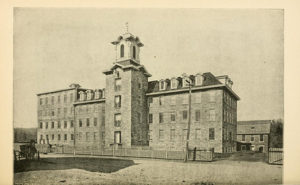 At the beginning of the twentieth century, the Connecticut State Legislature was seeking a solution to the overcrowding of the state’s only mental health facility in Middletown. In 1897, the city of Norwich offered to donate a tract of land for a new facility.
At the beginning of the twentieth century, the Connecticut State Legislature was seeking a solution to the overcrowding of the state’s only mental health facility in Middletown. In 1897, the city of Norwich offered to donate a tract of land for a new facility.
Eventually in 1903, the offer of 172 acres of land adjacent to the Thames River in Preston known as Brewster’s Neck was approved by the state legislature as the site for a new hospital. Construction of the initial buildings for new facility, named the Norwich State Hospital for the Insane was completed within a year, and the facility admitted their first patients in October of 1904.
The design of the hospital’s campus was a blend of 19th century architecture typified by large institutional buildings and a contemporary vision of smaller buildings or cottages. The large administrative building was flanked by two residential wings, each with a capacity for fifty patients.
The campus also included a large kitchen and bakery, a medical laboratory, an amusement hall and a powerhouse. During the early years of the hospital’s existence it rapidly surpassed its residential housing capacity with a total of 170 patients living at the facility.
By 1930 the hospital’s campus had expanded to over thirty buildings. However the problems of patient overcrowding continued to plague the hospital. Chronic understaffing due to high employee turnover and a low physician to patient ratio fueled complaints of patient neglect and led to several state investigations. During the 1940’s the hospital’s physicians instituted the controversial treatments of electro-convulsive therapy and pre-frontal lobotomies for patients.
The appointment of Dr. Ronald Kettle as superintendent ushered in a period of substantial positive changes to the hospital during the period of 1948-1966. Along with the construction of eight new state-of-the-art buildings, Kettle established formal guidelines making the humane treatment of the hospital’s patients the highest priority.
After 92 years, the Norwich State Hospital formally closed as an institution in October 1996. To see photographs of the buildings and grounds of this former institution visit the Otis Library’s Flickr page on the library’s website.
